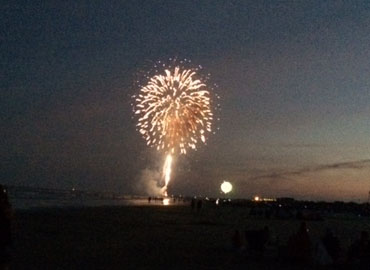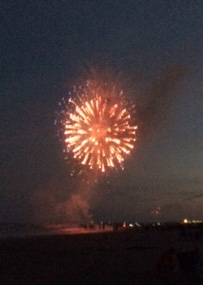
Independence Day is here; this weekend fireworks will light up the sky around the nation in celebration. But…how are fireworks made? And…who thought to send brightly colored explosions into the sky?
For Arbordale celebration and science go hand in hand, so here is a quick history chemistry and physics lesson in fireworks!
History
The Chinese were experimenting with exploding tubes of bamboo as early as 200 B.C., but it wasn’t until 900 A.D. that Chinese chemists found a mix that when stuffed in bamboo and thrown in a fire produced a loud bang. Over the next several hundred years experimentation lead to the first rockets, but as fire power began to fly in the air, celebrations also began to light up the sky.
Soon firework technology began to spread across Europe to Medieval England. The popularity of celebrating war victories and religious ceremonies with fireworks displays grew. The Italian pyrotechnic engineers are first credited with adding color to their fireworks in the 1830’s. The Europeans brought their knowledge of fireworks to America, and the first recorded display was in Jamestown in 1608.
 John Adams predicted that fireworks would be part of the Fourth of July celebrations on July 3, 1776 with a letter to Abigail Adams where he said, “I am apt to believe that it will be celebrated by succeeding generations as the great anniversary festival. It ought to be commemorated, as the Day of Deliverance by solemn Acts of Devotion to God Almighty. It ought to be solemnized with Pomp and Parade, with Shews, Games, Sports, Guns, Bells, Bonfires and Illuminations from one End of this Continent to the other from this Time forward forever more.”
John Adams predicted that fireworks would be part of the Fourth of July celebrations on July 3, 1776 with a letter to Abigail Adams where he said, “I am apt to believe that it will be celebrated by succeeding generations as the great anniversary festival. It ought to be commemorated, as the Day of Deliverance by solemn Acts of Devotion to God Almighty. It ought to be solemnized with Pomp and Parade, with Shews, Games, Sports, Guns, Bells, Bonfires and Illuminations from one End of this Continent to the other from this Time forward forever more.”
And so on the first anniversary of the country and each year we celebrate with Pomp and Parade, ending the day with Illuminations!
The Science
The Chinese put bamboo in the fire and the air pocket would make a bang when it was heated to a certain temperature. Today we have much better technology and fireworks are a little more complicated. The basic science has not changed, but the delivery methods have gotten much more accurate and high tech giving celebrators a bigger better show.
We know a tube is our vehicle, but how does it travel to the sky?
A mix of combustible solid chemicals is packed into the tube, along with neatly arranged  metals. The metals determine the color (copper=blue/green, calcium=red), and the arrangement determines shape (circle, smiley faces, stars).
metals. The metals determine the color (copper=blue/green, calcium=red), and the arrangement determines shape (circle, smiley faces, stars).
When the heat activates the chemicals, the excitement begins. The reaction is started by either fire or electricity through a fuse. As the heat begins to travel into the tube the chemicals become activated that reaction produces other chemicals such as smoke and gasses. The chemical reaction creates the release of energy; the energy is converted into the heat, light, sound and movement that we see up in the sky.
Physics takes over!
The Conservation of Energy Law says that the chemical energy packed inside that tube is equal to the energy of the released plus the energy left after the reaction. A professional firework in a large tube packed with chemicals creates a much bigger light show and bang than a tiny firecracker that jumps with a small bang.
The fireworks fly because of Newton’s Third Law. “For every action, there is an equal and opposite reaction” When the gasses are released from the chemical reaction they shoot down with force cause the firework to lift up into the air.
Finally, Why are fireworks always symmetrical?
 Conservation of Momentum says that momentum must be the same before and after the explosion. In other words, when the explosion occurs the movement must be balanced.
Conservation of Momentum says that momentum must be the same before and after the explosion. In other words, when the explosion occurs the movement must be balanced.
Now that you have learned a little about the science behind fireworks enjoy watching them on this Independence Day. But remember, fireworks are dangerous and best left to the professionals!


